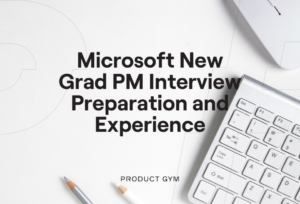Today, paying for something online is as easy as a few clicks. However, this wasn’t always the case, with transactions between buyers and online merchants requiring physical checks sent via the mail. PayPal was one of the first companies to bring about the evolution from “old school” payment methods to a fully digital payment experience. And now, PayPal has expanded into new virtual and in-person spaces, with PayPal accepted at online and physical stores alike.
Want to be part of this groundbreaking and influential financial technology company? We can help. In this guide, we’ll cover everything you need to know about becoming a PayPal Product Manager.
Become a PayPal PM: Company Overview
PayPal Holdings, Inc. is an online payments and financial services company that has powered virtual transactions for more than 20 years. The company encompasses several brands, including Venmo, Xoom, and Honey, and has partnered with several other well-known global financial organizations, such as Visa, Bank of America, JPMorgan Chase, and Wells Fargo, to increase their reach and customer base.
History
In 1998, Peter Thiel, Max Levchin, and Luke Nosek founded Confinity, the digital wallet that would later become PayPal. The name change happened after Confinity merged with X.com, Elon Musk’s financial services company. PayPal quickly became the payment option of choice among shoppers and sellers on eBay, the wildly popular online auction site. This success drove the company’s IPO in 2002. Soon afterward, however, eBay went ahead and acquired PayPal for $1.5B.
As a subsidiary of eBay, the company grew rapidly, with approximately one in four auction transactions closing via PayPal. The business also began to expand their product offerings, particularly around security and identity protection. Another strategic initiative was the introduction of PayPal as a payment option in brick-and-mortar stores. In 2012, the company announced a partnership with Discover Card that would give customers the option to pay with PayPal where Discover Card was accepted. In addition, PayPal grew their merchant services, introducing PayPal Working Capital and acquiring Braintree in 2013.
PayPal Today
In 2015, eBay spun PayPal off as its own publicly-traded company (NASDAQ: PYPL). The following years were marked by a number of acquisitions, beginning with international money transfer company Xoom in 2015. Other notable examples include Swift Financial in 2017 and iZettle, Hyperwallet, and Simility in 2018. The company made its largest acquisition to date in January of 2020, purchasing e-commerce-focused browser extension Honey for $4B.
Today, PayPal is headquartered in San Jose, California and helmed by CEO Dan Shulman. The company employs more than 27,700 people and earned annual revenues in excess of $24 billion in 2021. As of September of 2021, PayPal had 416 million active accounts and was processing nearly 37,000 transactions every minute.
Product Culture at PayPal
PayPal provides a number of products and services for individuals, businesses, and developers. Brands geared toward individual consumers include automatic coupon site Honey, mobile payment app Venmo, and money transfer service Xoom. In addition, PayPal offers PayPal Credit and prepaid cards, cashback rewards, buy now, pay later options, direct deposit services, bill pay, and other tools for everyday consumers. Many of these are available through the PayPal mobile app.
On the business and merchant side, PayPal structures its product lines by company size. For small-to-medium businesses, PayPal offers solutions for accepting online and in-person payments, detecting fraud, taking credit card payments, growing their customer base, and more. The company also provides similar services for enterprise clients, but on a much larger scale. Brands like fraud detection tool Simility, point-of-sale solution Zettle, and payment system Braintree are targeted at business accounts.
Finally, PayPal offers products for developers to work with PayPal APIs. These include a number of software development kits (SDKs), a sandbox testing environment, reporting solutions, and more.
Overall Company Culture
PayPal’s corporate mission is “to democratize financial services to ensure that everyone, regardless of background or economic standing, has access to affordable, convenient and secure products and services to take control of their financial lives.” The company’s four core values reflect this commitment to financial accessibility and service:
- Inclusion: Respect and value uniqueness and diversity of thought. We’re talking everyone, everywhere, at all times, regardless of background, level or circumstance. Ideas are richer and execution is stronger when everyone feels included.
- Innovation: Create amazing experiences for our customers – whether merchant, consumer or the PayPal community. Think differently, look end-to-end and practice empathy by putting yourself in our customers’ shoes.
- Collaboration: Work as a team, drive ownership and accountability, make decisions and get results. Foster trust, have integrity, champion each other and have each others’ backs. Eradicate silos and win as a team.
- Wellness: Care for and actively support each other’s well-being. Create a super energizing workplace that brings out the best in our employees by nourishing our mental, physical and emotional balance.
As a PayPal Product Manager, you are expected to be a team player, creative thinker, and customer-focused innovator. PayPal team members also receive a number of perks and benefits, including tuition assistance, stock purchase options, sabbatical programs, paid parental leave, donation matching, legal assistance, and more. In addition, the company is committed to a variety of charitable causes, particularly around small business growth, financial support for underserved groups, and social justice.
Product Team Culture
According to the PayPal careers site, product managers at the company should be ready to “lead the process of defining new ideas for customers and leading teams across every function, through every stage of development.” Product Managers at PayPal must be able to work well with other teams and be prepared to study customer pain points in detail.
How to Get a Product Manager Job at PayPal
At Product Gym, we apply a simple four-step framework to landing the Product Manager job you’re looking for. With this structure and the support of the PG community, both aspiring and veteran PMs have increased the number of calls they receive for interviews. The process also leads to more of those interviews being converted into offers.
Here’s how the magic works:
1. Optimize
From the best techniques for writing a cover letter to building an attractive Product Manager resume, the first step is to boost your credibility and professional branding. To get the offer from PayPal, you’ll need:
- A resume designed to beat the ATS
- A cover letter that shows your culture fit
- An optimized LinkedIn profile that aligns with the above
- A 30-second personal pitch that sells you as the best possible candidate
At Product Gym, we provide branding workshops, resume reviews, and the tools you need to take your professional branding to the next level.
2. Apply
Product Gym members apply for 20+ Product Manager jobs weekly, and often average 9+ interviews in any given week. But how’s that going to help you get the job at PayPal? Simple: by perfecting your application strategy and interview approach through practice and experience, you’ll build the confidence and expertise you need to wow the recruiter and interviewers at your dream company when the time comes.
Of course, our tried and tested application framework is paired with tools, tips, and interview support that all come together to form a job-hunting strategy that really works.
3. Convert
Once you’ve lined up your interviews, it’s time to zero in on converting those round ones into round twos, and so on, all the way to the PayPal Product Manager job offer. It’s no secret that we focus on the Product Manager interview process here at Product Gym: we’re there to help our members learn how to ace every step and every question — including behavioral questions, technical questions, case studies, salary negotiation, and more.
4. Learn
When should you start building your product management skillset? Before you apply? When you’re on the job? Honestly, transitioning into product management can be a long journey. We encourage Product Managers (whether you’re a first-timer or an industry vet) to start learning at the beginning and continue on past the finish line.
You likely already have skills that translate well into a Product Manager role: keep sharpening them, and find the gaps where you can learn, grow, and practice new skills to become a better Product Manager every day.
We want to make sure our members show up skilled and prepared for their interviews and their first day on the job, which is why we offer 20+ technical and business courses taught by industry experts.
What Does a Typical PayPal Product Manager Job Posting Look Like?
PayPal’s Product Manager job postings begin with a description of PayPal’s mission and core values. Next comes a brief overview of the role, which is generally followed by a list of responsibilities and key tasks. After that, the PayPal Product Manager job description goes into required skills/prerequisites section, which lists the qualifications the candidate should have. In general, PayPal Product Managers should possess the following:
- 5+ years of product management experience, with some roles requiring experience in specific fields
- Excellent analytical skills
- Strong collaboration and teamwork skills
- The ability to multitask and work in a fast-paced environment
- Curiosity and an open mind
- A track record around product strategy and feature delivery
The job listing ends with a section outlining PayPal’s long history in the financial tech space, along with a statement about equal opportunity employment.
While salary is generally not listed in the job description, Glassdoor puts PayPal’s average Product Manager salary at about $140K annually. Senior PMs can expect to earn $160K per year.
How Do You Get a Product Manager Interview at PayPal?
Get started by browsing PayPal’s current job openings to find the role(s) that best fit your expertise, experience, skills, and goals. Once you’ve identified one (or more!) that seems promising, you’ll need to craft a standout application — and that starts with a great resume.
1. Write a Fantastic Product Manager Resume
The PayPal Hiring Manager will probably look at your resume first. Be sure to highlight your relevant job experience and your Product Manager skill set, along with any qualifications involving the responsibilities and tasks listed in the job opening. If you can point to previous quantitative results around those aspects of the position, definitely do so.
Before updating your resume, check out our free webinar on resume writing, which takes you through the process of creating a resume that you can use for multiple Product Manager roles.
2. Position Yourself as an Excellent PM Hire
Your next step is to demonstrate your product management skills by writing a pitch that outlines the Product Manager position’s key responsibilities. You’ll need your personal elevator pitch polished and ready for the interview process, where you’ll use it to showcase your history and experience.
3. Apply!
Now it’s time to submit your application. But don’t stop there — if you know any employees at PayPal, see if they’d be willing to give you a referral. According to Glassdoor, 16% of interviewees got their foot in the door through an employee referral. Also, our step-by-step recruiter networking methodology can help you secure that first interview.
What Is the PayPal Product Manager Interview Process and Timeline?
PayPal’s Product Manager hiring process typically follows these steps:
- Introductory call with the Hiring Manager
- Technical and behavioral round with team members and stakeholders
- The offer
The process generally takes between three and six weeks from end to end. According to Glassdoor, 51% of interviewees had a positive experience, and the average difficulty was rated a 2.9 out of 5.
How to Win the Introductory Call With the Hiring Manager
During this first round, your goal is to clearly show that you’re qualified enough to move on to the next stage. On their careers site, PayPal actually gives some information about what they’re looking for in this conversation. Candidates should share what they’re passionate about and which problems they most want to solve. They should also be ready to demonstrate that they’re talented collaborators, risk-takers, and quick learners.
Here are some examples of PayPal Product Manager interview questions you should be prepared to answer:
- Why do you want to work for PayPal?
- What excites you about product management?
- Tell me about yourself.
- Tell me about your favorite product and what you would change about it.
- Tell me about the product you currently manage.
- What is your superpower as a product manager?
- Tell me about a time when you used data to reach a conclusion.
- Tell me about a time you received constructive feedback from your manager.
- What are your strengths?
- What is the toughest problem that you have solved as a Product Manager?
- What would be a deal-breaker (in a role) for you?
If you impress the Hiring Manager, you’ll be asked to move on to the technical round with additional members of the team.
How to Win the Technical Round With the Hiring Manager and Team Stakeholders
During this round, you’ll meet with multiple members of the product and product-adjacent teams at PayPal. Here are some of the technical PayPal interview questions to expect:
- Design a data analysis product based on employee data which can be used by both technical and non-technical people
- Tell me about a situation when you faced conflict with the tech team and how did you went about handling it
- Tell me about a time when you had to deny a feature request from senior management.
- You are a PM and you are about to enter a product launch meeting with all stakeholders. How would you prepare for that meeting?
- How would you reduce PayPal’s operating costs by 50%?
- How do you prioritize requirements?
- Tell me a time when you influenced engineering to build a particular feature.
- How would you improve Venmo?
- A B2B payment cards issuing company has observed a sudden drop in the use of their cards on e-commerce platforms in the month of April. Analyze the problem using appropriate assumptions. Suggest solutions to get the usage back on track.
- Suppose you’re the PM of an API that can analyse and categorize user’s spends. What are the key metrics you would track to measure the success of this feature?
- How would you improve the take rate for Paypal. Take rate is the percentage of revenue that paypal charges its merchants for all transactions via Paypal.
- The pandemic has changed people’s behaviors and payments preferences. Use all publicly available data to get insights on these shifts and pitch short and medium term investments the PayPal payments platform team should make.
After this round, the decision is in the hands of the hiring team. Best of luck!
How Did COVID-19 Change Hiring at PayPal?
Like most companies, PayPal switched to a fully-remote interviewing process during the COVID-19 pandemic. However, unlike many companies, PayPal saw significant business growth during the crisis due to the increase in online shopping. In fact, the company tripled their profits in Q4 of 2020. They’ve also continued to hire, and have more than 2,700 positions currently open, including several on the product team.
According to CEO Dan Schulman, most PayPal employees will likely follow a hybrid schedule, balancing time between the office and home/virtual, when the company’s offices reopen.
Become a PayPal Product Manager
Want to learn more about becoming a PayPal Product Manager or getting hired at a well-known company? Our career coaches are now offering free sessions: schedule yours today. We’d be glad to answer any of your questions.



